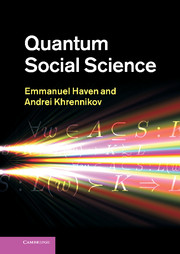Book contents
- Frontmatter
- Dedication
- Contents
- Foreword
- Preface
- Acknowledgements
- List of symbols
- I Physics concepts in social science? A discussion
- II Mathematics and physics preliminaries
- 4 Vector calculus and other mathematical preliminaries
- 5 Basic elements of quantum mechanics
- 6 Basic elements of Bohmian mechanics
- III Quantum probabilistic effects in psychology: basic questions and answers
- IV Other quantum probabilistic effects in economics, finance, and brain sciences
- Glossary of mathematics, physics, and economics/finance terms
- Index
4 - Vector calculus and other mathematical preliminaries
from II - Mathematics and physics preliminaries
Published online by Cambridge University Press: 05 July 2013
- Frontmatter
- Dedication
- Contents
- Foreword
- Preface
- Acknowledgements
- List of symbols
- I Physics concepts in social science? A discussion
- II Mathematics and physics preliminaries
- 4 Vector calculus and other mathematical preliminaries
- 5 Basic elements of quantum mechanics
- 6 Basic elements of Bohmian mechanics
- III Quantum probabilistic effects in psychology: basic questions and answers
- IV Other quantum probabilistic effects in economics, finance, and brain sciences
- Glossary of mathematics, physics, and economics/finance terms
- Index
Summary
Linear spaces
In essence vector spaces are quite simple mathematical objects. We can distinguish between so called ‘real vector spaces’ and the maybe less used ‘complex vector spaces’. The former uses real numbers, while the latter uses complex numbers. For the novice reader, many textbooks will give a definition of such a space and they very often will go into more detail (such as on covering the notion of subspaces; product of spaces and span). Hubbard and Hubbard [1]; Kreyszig [2] and Ha [3] are good examples.
The real vector space V is characterized by i) commutativity in addition and hence for two vectors a, b ∈ V: a + b = b + a; ii) associativity in addition and hence for vectors a, b, c ∈ V:(a + b) + c = a + (b + c); iii) the existence of a vector 0 ∈ V such that: a + 0 = a; iv) for each vector a ∈ V there exists an additive inverse, −a :(−a) + a = 0. Moreover, for real scalars a, β ∈ R and vectors a, b ∈ V, the following simple laws need to be satisfied: i) 1a = a; ii) (α + β) a = αa + βa (distributivity towards scalars); iii) α (a + b) = αa + αb (distributivity towards vectors): iv) α (βa) = (αβ) a (associativity). The complex vector space is obtained by just swapping the real scalars for complex scalars.
- Type
- Chapter
- Information
- Quantum Social Science , pp. 71 - 83Publisher: Cambridge University PressPrint publication year: 2013



